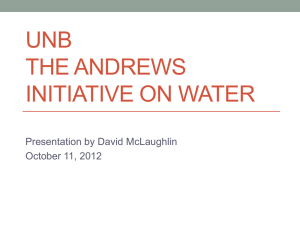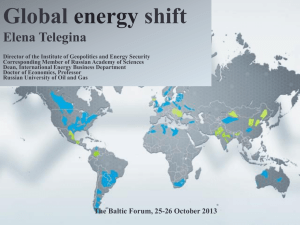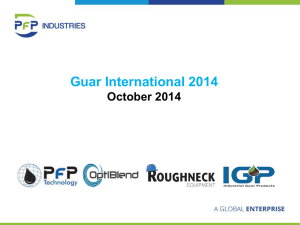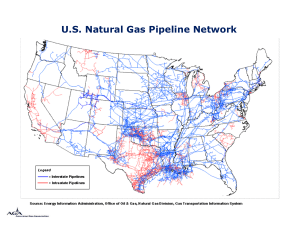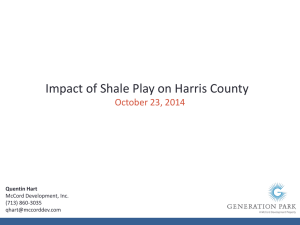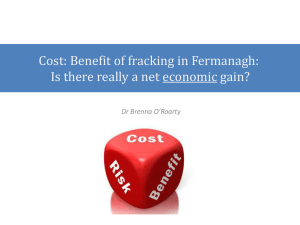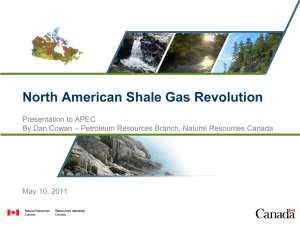Responsible Shale Development
advertisement
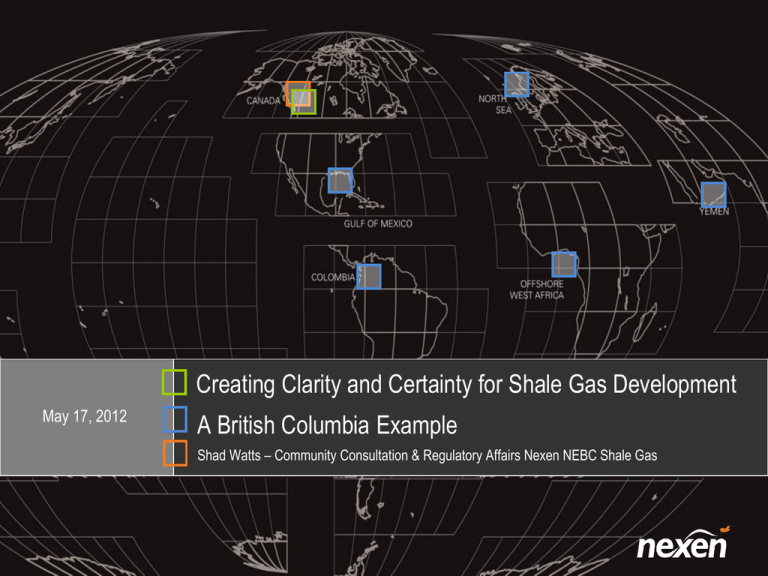
Creating Clarity and Certainty for Shale Gas Development May 17, 2012 A British Columbia Example Shad Watts – Community Consultation & Regulatory Affairs Nexen NEBC Shale Gas Shale Gas Case Study Agenda Nexen NEBC Shale Gas Overview and Challenges Opportunities to Create Certainty and Clarity Tenure Acquisition Fiscal Incentives Effective & Efficient Regulation Shale Gas Overview Northeast British Columbia Nexen Asset Positioning Nexen Ownership Summary ~172,000 acres in Horn River and Cordova Nexen Total NEBC Basin Acreage: ~300,000 net acres ~128,000 net acres ~90,000 net acres ~82,000 net acres ~128,000 acres in Liard 60% working interest 100% operated Ownership in Cabin Gas Plant Takeaway Capacity Spectra Plant 100 MMcf/d Cabin Gas Plant 5% Nexen WI in Phase 1 400 MMcf/d gross processing capacity Expected online mid2012 20% Nexen WI in Phase 2 400 MMcf/d gross processing capacity NEBC Shales (Horn River: 104 Tcfe) BRITISH COLUMBIA Horn River Muskwa Potential LNG Facility BRITISH COLUMBIA/ ALBERTA Montney Montney: 55 Tcfe Horn River Basin: Top Quartile Shale Play in North America WILLISTON BASIN Bakken UINTA BASIN Baxter Mancos SAN JOAQUIN BASIN McClure PARADOX BASIN Cane Creek BIG HORN BASIN Mowry PICEANCE BASIN North American Unconventional Resource Plays SAN JUAN BASIN Mancos Lewis Utica APPALACHIAN BASIN Marcellus Huron ARKOMA/ARDMORE BASIN Fayetteville Woodford Caney DELAWARE BASIN Barnett Woodford 500 net foot interval averages 50% thicker than the Barnett High silica content shale is very brittle and fracable Marcellus Shale: 197 Tcfe Woodford Shale: 12 Tcfe SANTA MARIA BASIN Monterey Third largest resource play in North America MICHIGAN BASIN Antrim Fayetteville Shale: 26 Tcfe BLACK WARRIOR BASIN Floyd Conasuaga Neal Barnett Shale: 61 Tcfe Haynesville Shale: 140 Tcfe Eagle Ford Shale: 10 Tcfe 10+ year land tenure with minimal drilling required to hold Attractive tax regime and royalty structure Competitive resource recovery (EUR) with 6 – 15 Bcf wells Viable North American LNG export option Ideally located to supply growing oil sands demand Cordova Embayment extends platform ____________________ Resource Potential Estimate Source: Wood Mackenzie. 2 Shale Gas Overview Northeast British Columbia 4 STAGES OF SHALE GAS EXPLORATION AND DEVELOPMENT • A stepwise approach through exploration and appraisal… • Technical feasible – defining and characterising the a viable play concept; • Commercial feasiblity – cracking the nut leading to cost effective reservoir productivity; • Commercial demonstration through pilot programs prior to project sanction 30+ Shale Gas Overview Development Requirements NEBC 1. Permanent Roads and year round access. 2. Well pads with many (8-20) horizontal wells • • • • One pad per 3 square miles. Triple Drill Rigs (5000m); self moving Surface footprint only 5-10% of traditional equivalent vertical well development Innovative application of technology to reduce development costs. 3. Completion (fracing) of Horizontal Wells. • 16-20 fracs per well. • 3+ fracs per day. • exclusively slick water* fracs . • typically 200-350 tonnes sand per frac (2-4 railcars). 4. Appropriate pipelines to and from the well pads *Slickwater or slick water fracturing is a method or system of hydro-fracturing which involves pumping water & sand with a friction reducer. 6 Shale Gas Overview Development Requirements NEBC 5. In field Facilities / Gas Compression • Dehydrate and compress gas • Formation water filtration & disposal 6. Takeaway pipeline to Area Gas Plant(s) 7. Area Gas Plants that will further process the gas • Remove CO2 and trace H2S • Compress to sales pipeline pressures 8. Sales pipeline to transport gas to market 7 Shale Gas Overview Horn River Basin – Drilling (18 well pad) b-77-H/94-O-8 Pad 2011 Shale Gas Overview Horn River Basin – Completions (9 well pad) c-1-J/94-O-8 Pad 2011 Shale Gas Overview Development Challenges NEBC • Distance to market • Undeveloped local service sector / distance to services • Lack of infrastructure and difficult surface access • Understanding the reservoir • Long time before positive return Shale Gas Overview Development Challenges NEBC Large upfront capital requirements Drilling = $127,687/day Completions = $640,693/day (excluding materials) Field Infrastructure 8% Pad Facilities & Pipelines 9% Pad Construction 2% Site Operations 14% Drilling 24% Completions 43% 11 Shale Gas Overview THE SHALE GAS DEVELOPMENT CHALLENGE Deliverability and EUR for each well ? How much is it going to cost ? What to put on the books ? How much infrastructure and when to expand ? How to reliably assess to services? Market contracts and takeaway capacity ? How to get the most gas using the least frac water & proppant ? How many frac stages & how far apart ? Best flowback practices to enhance performance ? What is the best well spacing, length & orientation ? Where should laterals be placed ? Is there a sweet spot in the reservoir ? Planar bi-wing or complex fracs ? How much free & absorbed gas ? How important are natural Fractures ? Shale Gas Overview Key Messages – What It Takes Quantitative – Below Ground • Positive expected monetary values Cumulative distribution of NPV that incorporates mitigation decision points and key subsurface risk and uncertainty ranges • Acceptable risked capital levels • Attractive success case valuation Qualitative – Above Ground • Favorable fiscal terms and incentives that promote exploration and risk sharing • Terms of tenure aligned with the “unconventional” timelines for exploration, appraisal and development • Sanctity of contract • Stable, streamlined, open and transparent regulatory structure • Infrastructure to customer • Liberalized gas market • Political stability • Secure and predictable operating environment • Legitimate government consultation on regulation, terms and policy Shale Gas Case Study Agenda Nexen NEBC Shale Gas Overview and Challenges Opportunities to Create Certainty and Clarity Tenure Acquisition Fiscal Incentives Effective & Efficient Regulation Certainty in Subsurface Rights Oil & Gas Tenure Tenure Must Facilitate Responsible Development: • Should stimulate work activity rather than be viewed as a revenue generation mechanism • Clear definition of exclusive rights geographically • Appropriate to resource developed in the term, and geographical extent • Risk sharing through flexibility in commitments for work or cash in lieu with optionality for staged commitments related to market. • Maintains competitiveness through market pricing with no minimum bids but don't have to award if less than fair award price 15 Certainty in Subsurface Rights Oil & Gas Tenure Principles of British Columbia’s Tenure System • Exploratory effort is rewarded with the right to produce, delineation of a pool allows the tenure to be held beyond the end of its term • Longer tenures are granted in areas with poorer infrastructure • Oil and gas tenure grants the rights to the resource only - permitting of exploration and development activities is managed separately by an independent agency • Unused rights return to the Crown at the end of the tenure term 16 Certainty in Subsurface Rights Tenure Types in BC Drilling Licences (3, 4, or 5yr term) • Exploration type of tenure • Different terms depending on location • Encourages Development Leases (5 or 10yr term) • Production form of tenure • Held in perpetuity 17 Shale Gas Case Study Agenda Nexen NEBC Shale Gas Overview and Challenges Opportunities to Create Certainty and Clarity Tenure Acquisition Fiscal Incentives Effective & Efficient Regulation Shale Gas Case Study A SUCCESSFUL FISCAL REGIME • Fiscal regime that shares risk / incents activity • Provides long term certainty • Enable accelerated capital cost recovery for capital intensive plays • Facilitate resource development through access cost sharing in remote areas (roads and pipe) • Incent zone specific production through target credits • Recognize seasonal or operational constraints Fiscal Incentives BC’s Targeted Royalty Programs British Columbia Targeted Royalty Programs Summer Royalty Program Deep Royalty Programs • Deep • Deep Discovery • Deep Re-entry Conditions: • Spud Date between April 01 & November 30 Conditions: • Vertical Well Depth > 2500m • Before Sep 1, 2009 Horizontal Well Depth > 2300m • After Sep 1, 2009 Horizontal Well Depth > 1900m Marginal Royalty Program Ultra-Marginal Royalty Program Coalbed Methane Conditions: Condition: Condition: • 12 month average Rate < 40 mcf/d/100m • Production < 600 mcf/d • 12 month average Rate < 80 mcf/d/100m Infrastructure Royalty Credit Program Net Profit Royalty Program Condition: Conditions: • By Request for Applications • By Request for Applications • Monthly Production below 880 mcf/d 20 Fiscal Incentives Impact of BC Royalty Programs • $1.3 billion in incremental royalties since 2004/05 21% increase in BC’s natural gas revenues • 21 Shale Gas Case Study Agenda Nexen NEBC Shale Gas Overview and Challenges Opportunities to Create Certainty and Clarity Tenure Acquisition Fiscal Incentives Effective & Efficient Regulation Efficient and Effective Regulation • Considers Operational requirements, risk, and technical considerations • Built collaboratively • Flexible • Approvals received in a timely manner • Incent desired practices • Results based – focus on compliance Effective & Efficient Regulation Provincial Legislative Framework Government and Ministries •Set Policy and Legislation •Award Tenure E.g. Oil and Gas Activities Act Oil and Gas Commission •Provides Permits & Approvals •Compliance & Enforcement E.g. Drilling and Production Regulation Effective & Efficient Regulation One Window Approach Specified Enactments Land Act: Section 14 Temporary Occupation of Crown Land Section 39 Licence of Occupation Section 40 Right of Way The BC Oil and Gas Commission serves as a “single window” agency provided with legislative authority for authorizations under several Acts. Water Act: Section 8 Short Term Use of Water Section 9 Changes in and About a Stream Section 26 Permits over Crown Land Forest Act: Section 47 Master Licence to Cut Section 117 Road Use Permit Other Enactments: Section 12 Heritage Conservation Act Sections 9, 14 & 15 Environmental Management Act 25 Effective & Efficient Regulation Regulatory Framework Structure of OGAA Oil and Gas Activities Act (OGAA) • • • • • • More efficient approvals for multiple related activities Increased compliance and enforcement mechanisms Increased landowner/stakeholder support Increased environmental protections New appeal provisions Maintains specified enactments Geophysical Exploration Regulation Drilling & Production Regulation Pipeline Regulation Administrative Penalties Regulation Consultation and Notification Regulation Environmental Protection & Mgmt Regulation 26 Effective & Efficient Regulation One Window Approach Project Lifecycle – What the Commission Regulates 1. 7. Abandonment / Reclamation • • Pre-Application • Certificate of Restoration Process Orphan Fund Consultation/Engagement by Industry with landowners, other stakeholders/First Nations and Government/Commission 6. Operations • • 2. Risk based inspections Compliance Programs and Audits • • 5. Leave to Open/Production • Application 3. Decision (21 days) • Review project to ensure it is compliant and ready to commence operations First Nations Consultations Application Review • Permit issued or declined with reasons Conditions attached as appropriate 4. Construction • Inspections and Enforcement 27 Effective & Efficient Regulation Streamlined Application WELL PERMIT APPLICATION FORM OGC, 100 10003 110 AVE Fort St. John, B.C. V1J 6M7 Phone: (250) 794-5200 FLFN FNFN Other HRFN WMFN Archaeological Assessment Information Form Archaeological Reports, if available Other: Fibre Utilization Plan Other Documents Date Received THIS IS AN AUDITABLE DOCUMENT FOR INSTRUCTIONS REFER TO THE WELL PERMIT APPLICATION MANUAL COMMISSION USE ONLY Commission File No.: A WA No.: Application Category: Document : Routine Well Classification: Non-Routine Objective Field: Application Fee: $ PETROLEUM & NATURAL GAS TENURE RIGHTS Directionally drilled Objective Field Code: B Applicant Name: Surface Coordinates: N/ Proposed Bottom Hole Location(s) & Heel Location (s) Address: Horizontally drilled Vertically drilled Well Centre Coordinates (UTM) Zone: ADMINISTRATION F Permit, Drilling Licence or Lease Number(s) (for bottom hole location(s), plus heel to toe locations): __________________________ _________________________ _________________________ _______________________ Is the applicant the registered holder of the petroleum and natural gas rights? Yes No G WELL SPECIFICATIONS N: S (m) E/ Objective Formation(s) W (m) Objective Fluid (oil, gas or water) E: from Objective Depth(s) (m TVD) corner of Ground Elevation (m): Expected TD Core (Y/N) ( m TVD) (m MD) Formation at: TD BOP Class City, Province, Postal Code: Contact: Referral Company: Email: Email: Agent Name: Phone: Phone: Internal File No.: APPLICATION INFORMATION ePASS No.: C Surface location (NTS/DLS): Well Name: New Permit Holder Application Fee Applicable Yes No Primary Well Application Subsequent Well Application with new area If this is a subsequent well application, enter the primary WA No.: _____________ and Commission File No.: _______________ Revision to Commission File No. : Bit Size (mm) Re-entry COR/WA No.: Water Source Well Is the water source well designed to operate at a rate greater or equal to 75 litres/second? Disposal Well Yes PROPOSED CASING PROGRAM Linear Density Grade New or Used (kg/m) Casing Size (mm O.D.) H Setting Depth (If directional, enter m TVD and in MD) No Injection Well Cross Reference to other Commission File No. (if applicable): Is this well within an area designated as a special project using innovative technology under section 75(1)(b)? Yes – Approval No.: _____________ No LAND STATUS Area Of Activity: North Central Forest District(s): South D MKMA ALR SYD Private Land Is there a Timber Reservation charged against the title? Review Corridor applied for Yes No Cross reference to existing review corridor, OGC file no.: Total woodlot licence area ha Total area private land ha Total area Crown land ha Total new Crown land area disturbance ha Total application area proposed ha Area of Crown land for wellsite only ha FIRST NATIONS CONSULTATION / ABORIGINAL COMMUNITY NOTICE PACKAGE N/A E Ensure the following are attached to the application for First Nations consultation purposes: Aboriginal Consultation Attachments Community Notice KLCN BRFN MLIB Cover letter (2 copies for each consultation and notification area affected) KLFN KLMSS DENE THA DRFN PRFN Application Form SFN Mapping requirements Gelchem KCI Air I Hydrocarbon Based: Other – Specify Type: Master Licence To Cut (MLTC) No.: Crown Land DRILLING INFORMATION Drilling fluid type: Underbalanced drilling? Yes No Managed pressure drilling? Is a remote sump being applied for with this application? Yes No If yes, remote sump must be shown on the construction plan. Yes No 3 SOUR WELL INFORMATION (H2S RELEASE RATE > 0.01 m /s) List expected sour zones and their corresponding maximum H 2S content (%): 3 Cumulative H2S release rate (m /s): Drilling: Completion: Emergency Planning Zone radius (km): Drilling: Completion: Distance to nearest occupied dwelling (km): Distance to nearest Urban Center (km): Are there any occupied dwellings, public facilities, numbered or named highways, rivers and lakes, Yes recreation areas, places of business and/or egress inside the calculated Emergency Planning Zone? N/A No 28 J Effective & Efficient Regulation Environmental Protection Horizontal Wells Vertical Wells • 20 Horizontal wells from one 260x175m pad • Would need 320 vertical wells • Each frac stage in hz well is equivalent to a vert. well • Vertical wells each on a separate 100m x 100m pad • Same amount reservoir contacted in both scenarios • 85% less surface disturbance 29 Effective & Efficient Regulation Environmental Protection Small Lake Complexes • Collaborative effort bw industry and government • Calf mortality decreases when selected • Calf recruitment success increases 2000 meters • Predators are avoiding/don’t select Lakes 1 ha – 10 ha within 200m proximity of each other 250m buffer applied 30 Effective & Efficient Regulation Water uses – Shale Gas What is Water Used For? Oil and Gas Road and well pad construction Drilling Well completions Transportation/pipelines 31 Effective & Efficient Regulation Water requirements Nexen Horn River Basin: • 1 pad per year • 16-18 frac stages per well, 20 wells per pad • Frac design: • 3300 m3 per frac stage and drill-outs • 60,000 m3 per well x 20 wells per pad • 200-350 tonnes frac sand per frac • Total annual requirement of ~1,200,000 m3 of water & 80,000 – 140,000 tonnes of sand 32 Effective & Efficient Regulation Water Protection - Well Construction Potable Groundwater Aquifers Potable Water Wells: <150-300 metres Surface casing Additional steel casing and cement to protect groundwater Protective Steel Casing Hydraulically fractured shales Approximately 2500 metres below surface 33 Effective & Efficient Regulation Licensed Withdrawal • Variable withdrawal rates are designed to mimic seasonal variations in flow 6.00 Instream Flow Range (2011) Withdrawal Parameter Flood Stage: 80% > inferred median > 1.652 m3/s 25% of mean daily discharge High Flow: > inferred median 0.918 – 1.651 m3/s 15% of mean daily discharge Normal Flow: < inferred median 0.918 – 0.352 m3/s 10% of mean daily discharge < 0.351 m3/s Zero Withdrawal Limit Maximum Withdrawal Limit (30% of mean annual flow - ice free period) 0 Total Discharge (April to October): 17 600 000 m3 3 Total Allowable Withdrawal: 3 400 000 m (19% of total) 3 Current use capacity: 2 000 000 m (12% of total) 5.00 Mean Daily Discharge (m3/s) Flow Condition 4.00 3.00 2.00 25% of MDF 2 500 000 m3/year 15% of MDF 1.00 10% of MDF 0 Withdrawa 0.00 22-Apr-10 12-May-10 1-Jun-10 21-Jun-10 Tsea River at W7 - 2010 Discharge Inferred Median Zero Withdrawal Limit 11-Jul-10 31-Jul-10 20-Aug-10 9-Sep-10 29-Sep-10 19-Oct-10 Tsea River at W7 - 2010 Allowable Withdrawal 34 Flood Stage 34 2010 Used Conclusions Capital Intensive Development Governments and industry need to work together Different phases of development need to be recognized Focus on results based regulatory framework to enhance efficiency and flexibility



